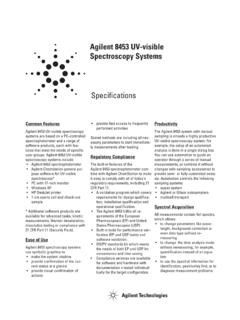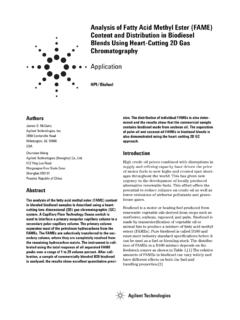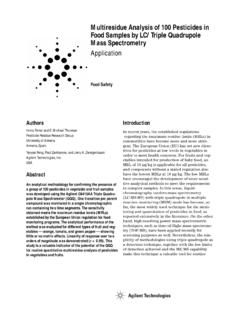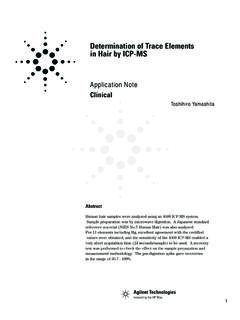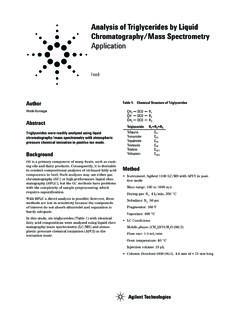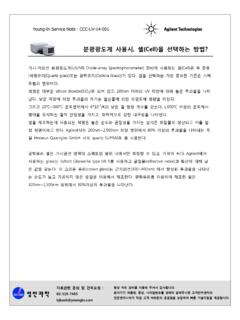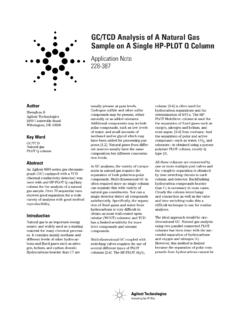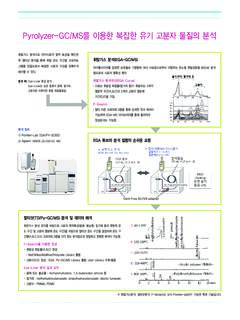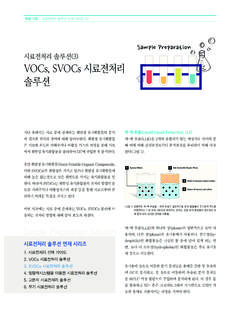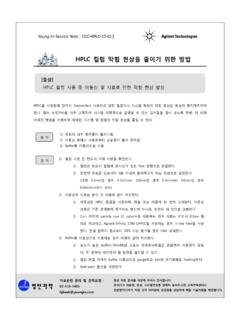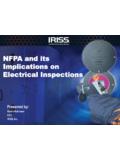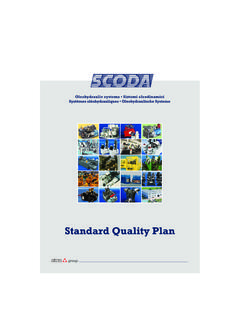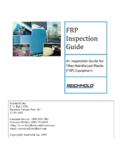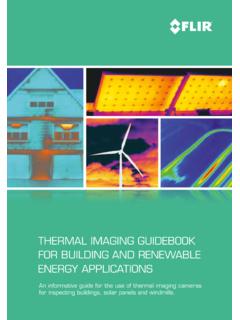Transcription of The Right Analytical Method for the Right …
1 GEWater & Process TechnologiesAnalytical Instrumentsimagination at workPaperThe Right Analytical Method for the Right Application: TOC analysis for Cleaning ValidationAdvances in technologies and mounting manufacturingcosts are leading the global pharmaceutical industry toevaluate alternate means to enable greater efficiency andproductivity. In this highly competitive industry, it is vital toensure the highest possible drug quality while eliminatinghigh production costs and unnecessarily lengthy validationwork. Interest in Total Organic Carbon (TOC) analysis as anon-specific Method for cleaning validation has grownconsiderably in recent years because specific analyticaltesting like High Performance Liquid Chromatography(HPLC) has proven to be a bottleneck in the cleaning valida-tion process, significantly contributing to equipmentdowntime after paper investigates the advantages of using a non-spe-cific Method for cleaning validation over more traditionalanalytical methods.
2 It also looks at TOC methods and iden-tifies why Sievers* TOC technology is well suited to cleaningvalidation applications. The goal is to help pharmaceuticalmanufacturers understand how using TOC can result ingreater resource productivity, improved yields, reducedequipment downtime, and better bottom lines. The Advantages of Using a Non-specificMethod (TOC) for Cleaning ValidationAn increasing number of companies are utilizing TOCanalysis for cleaning validation because it is faster, easi-er, and more economical than other Analytical TOC Method yields high sample throughput andreduces cleaning validation protocol execution time. Thisis true even with compounds generally thought to beinsoluble in water or with bulky proteins common in thebiotechnology industry. Furthermore, the FDA acceptsthe TOC method1in its regulatory guidelines for measur-ing contaminant a cleaning validation study it is often necessary toestablish acceptance criteria limits based upon more thanone target residue or compound.
3 HPLC is limited in that itcan determine only one residue for one individual givenassay. In cleaning validation, multiple compounds wouldthus require multiple Analytical tests. With these multipletests, unanticipated contaminants or cleaning agentscould potentially be overlooked and unknown peaks couldshow up on the chromatograph. TOC will detect more thanone target compound given it is a non-specific Weaknesses of HPLC: Ghost Peaks, RegulatoryScrutiny, and Costly MaintenanceDue to long setup and analysis times, HPLC often con-tributes one to two days of production downtime beforeprocessing equipment can be certified for peaks and costly maintenance have been theroot cause of this downtime. Additionally, HPLC is themost commonly cited Analytical Method in warning let-ters issued by the FDA after pharmaceutical facilityinspections. Recent warning letter statements referencing HPLC address insufficient detection, failure to identi-fy unknown peaks, failure to calibrate instruments prior touse, lack of linearity testing, instrument accuracy, andfailure to perform system suitability prior to training or qualifications for lab personnelrunning HPLC instruments are also scrutinized heavily.
4 Arecent Warning Letter stated ..procedures for conduct-ing HPLC testing are inadequate because sample runtimes and retention not been established inyour approved test methods. Our investigator found thatyour laboratory employees routinely stop chromato-graphic runs immediately after the active peak has elut-ed, and as a result, any peak that elutes after the activepeak will not be This heightened regulatory scrutiny shows that the FDA isaware of HPLC s disadvantages. This awareness is furtherindicated in the FDA Guide to Inspections ofPharmaceutical Quality Control Laboratories: Sometimesthe company s employees have insufficient training ortime to recognize situations that require further investiga-tion and explanation. Instead they accept unexplainedpeaks in chromatograms with no effort to identify It is no secret that performing HPLC analysis for cleaningvalidation involves some level of uncertainty.
5 Unknownpeaks, also known as ghost peaks, contribute to thisuncertainty, resulting in lengthy troubleshooting timeand failed validation operations. Peaks from previousinjections, contamination, bubbles, column fouling, worn-out guard columns, and trace contaminants or cleaningagents in the sample are some of the contributing factorsthat lead to costly replacement of parts on the HPLC unit .For example, worn polymeric fittings or tubing and a con-taminated guard column affect peak shape and requirereplacement . Depending upon the peak shape distortion,guard columns may require weekly or even daily replace-ment , greatly increasing unplanned maintenance of OwnershipAccording to various industry experts, the average capi-tal cost of a TOC analyzer is 30% to 40% lower than thatof an HPLC instrument . Most pharmaceutical facilitieshave a TOC analyzer in place for USP water release pur-poses.
6 The same analyzer can serve both USP and clean-ing validation functions, potentially eliminating the needfor a capital purchase entirely. Additionally, industrysources estimate operating costs for TOC analysis to be40% to 80% less than the cost of a HPLC instrument . Thisdoes not account for the additional time required for fre-quent maintenance, removing contaminates by recondi-tioning the column, using well-degassed solvents, dailycolumn equilibration, and daily calibration of the detec-tor. Operational costs for HPLC will increase due to unre-liable components and the multiple external parts need-ed to run the instrument Production Downtime Costs with HPLCThe "downtime calculator" shown in Table 1comparesproduction downtime costs associated with the analyticalmethods most commonly used in the pharmaceuticalindustry for cleaning validation. The downtime calculatordemonstrates the use of HPLC and TOC in an actual phar-maceutical company that is producing a blockbuster"therapeutic with 24/7 315 days of revenues for the product are referenced to be $ , with 750 resources contributing to the productionof the drug product.
7 By using TOC for cleaning validation,the pharmaceutical manufacturer can reduce productiondowntime costs by almost 100%.Ease of Use for a Non-Specific MethodAn HPLC operation requires attended sample analysisand specially trained personnel. TOC analysis requires nospecial training and reduces the Analytical Method devel-opment time by 60% to 70%. The use of TOC also reducesthe end user decision points, eliminating downtime andhuman error and streamlining the cleaning validation orverification process. Documentation for TOC analysis issimplified to ensure compliance and promote real-timedocumentation, thus facilitating rapid approval of labresults for the staged equipment . This allows for quickequipment turnaround time, which is crucial for pharma-ceutical Recovery of Insoluble OrganicsWith the use of a non-specific Method it has been arguedthat using TOC for cleaning validation did not providegood percent recoveries during cleaning validation stud-Table CalculatorPage 2 of 6 Source: Pharmaceutical manufacturerPage 3 of 6ies of insoluble organics.
8 Some argue that achievinggreater that 50% recovery with a non-specific methodanalyzing an insoluble compound is very unlikely. Table2demonstrates the swab percent recoveries of three"insoluble compounds" comparing HPLC to TOC. TheTOC recovery is from coupons spiked at 4 g/cm2orapproximately 2 parts per million (ppm) in 20 mL ofwater and demonstrates that the response efficiency iswell above 50%.Using Sievers TOC Analyzers for CleaningValidationGeneral TOC TheoryAll TOC analyzers perform two functions: the oxidation oforganic carbon in water to carbon dioxide (CO2) and themeasurement of the CO2produced. TOC can be used toquantify most of the impurities and residues in equip-ment that was not cleaned properly, and measures allcarbon-containing compounds: APIs (Active Pharma-ceutical Ingredients), cleaning agents, proteins, andintermediates. Analytical technologies utilized to meas-ure TOC share the objective of completely oxidizing theorganic molecules in an aliquot of sample water to CO2,measuring the resultant CO2levels, and expressing thisresponse as carbon concentration.
9 All technologiesmust discriminate between the inorganic carbon, whichmay be present in the water from sources such as dis-solved CO2and bicarbonate, and the CO2generatedfrom the oxidation of organic molecules in the is determined by subtracting the measured inor-ganic carbon (IC) from the measured total carbon (TC),which is the sum of organic carbon and inorganic carbon:TOC = TC analyzers are differentiated by the methods used tooxidize organics in the water sample and to detect theresulting CO2concentration within the sample. Differentmethods of detection can have a substantial effect onthe accuracy of the sample being analyzed, thus affect-ing the cleaning validation testing process. TOC Oxidation TechnologiesAll TOC analyzers on the market use one of two methodsfor oxidizing organic compounds and converting them toCO2gas: combustion or ultraviolet (UV) light with persul-fate combustion technique uses temperatures of at least600 C in a stream of nitrogen, oxygen, or air.
10 With thecombustion Method , a catalyst also is used to aid in theoxidation step. Catalysts used in this methodology aretypically cupric oxide, platinum, or cobalt UV Persulfate oxidation methodology utilizes UV lightto dissolve organics to fully oxidize to CO2. The sample isexposed to UV light from a mercury vapor lamp sourcewithin the instrument , converting the organics to CO2gas. For samples or compounds greater than 1 ppm, per-sulfate is added and mixed to the sample stream toensure oxidation on negatively charged hydroxyl (HO-)radicals generated from the irradiation of the is a powerful oxidizing agent that , in the pres-ence of UV radiation, can produce sulfate and hydroxylradicals capable of completely oxidizing organic com-pounds to CO2. TOC Detection MethodsIn order to detect the concentration of CO2, the analyzerneeds a detection Method to differentiate other mole-cules from the CO2present in the sample.
